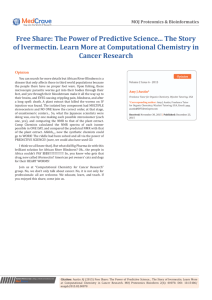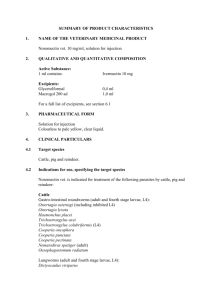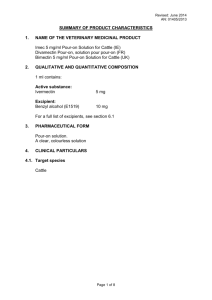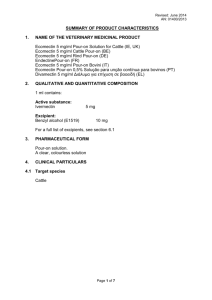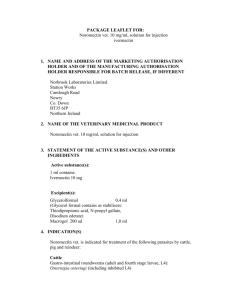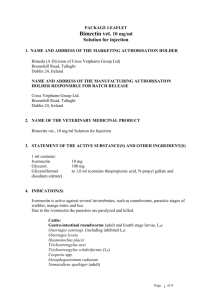as a PDF
advertisement
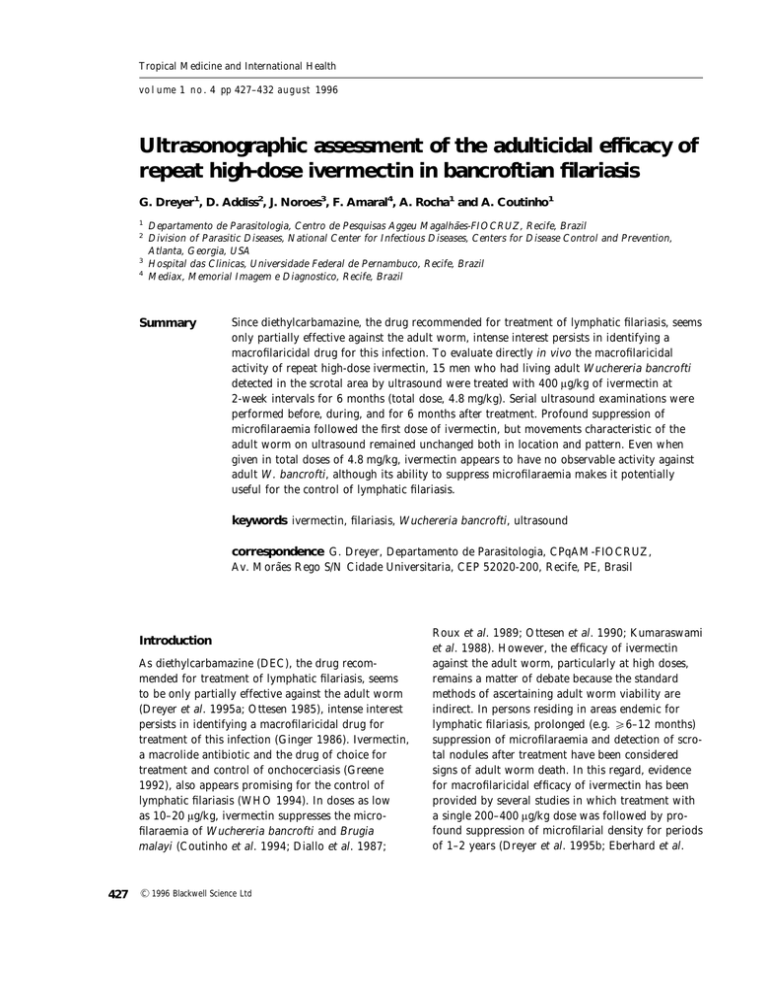
Tropical Medicine and International Health volume 1 no. 4 pp 427–432 august 1996 Ultrasonographic assessment of the adulticidal efficacy of repeat high-dose ivermectin in bancroftian filariasis G. Dreyer1, D. Addiss2, J. Noroes3, F. Amaral4, A. Rocha1 and A. Coutinho1 1 2 3 4 Departamento de Parasitologia, Centro de Pesquisas Aggeu Magalhães-FIOCRUZ, Recife, Brazil Division of Parasitic Diseases, National Center for Infectious Diseases, Centers for Disease Control and Prevention, Atlanta, Georgia, USA Hospital das Clinicas, Universidade Federal de Pernambuco, Recife, Brazil Mediax, Memorial Imagem e Diagnostico, Recife, Brazil Summary Since diethylcarbamazine, the drug recommended for treatment of lymphatic filariasis, seems only partially effective against the adult worm, intense interest persists in identifying a macrofilaricidal drug for this infection. To evaluate directly in vivo the macrofilaricidal activity of repeat high-dose ivermectin, 15 men who had living adult Wuchereria bancrofti detected in the scrotal area by ultrasound were treated with 400 ìg/kg of ivermectin at 2-week intervals for 6 months (total dose, 4.8 mg/kg). Serial ultrasound examinations were performed before, during, and for 6 months after treatment. Profound suppression of microfilaraemia followed the first dose of ivermectin, but movements characteristic of the adult worm on ultrasound remained unchanged both in location and pattern. Even when given in total doses of 4.8 mg/kg, ivermectin appears to have no observable activity against adult W. bancrofti, although its ability to suppress microfilaraemia makes it potentially useful for the control of lymphatic filariasis. keywords ivermectin, filariasis, Wuchereria bancrofti, ultrasound correspondence G. Dreyer, Departamento de Parasitologia, CPqAM-FIOCRUZ, Av. Morães Rego S/N Cidade Universitaria, CEP 52020-200, Recife, PE, Brasil Introduction As diethylcarbamazine (DEC), the drug recommended for treatment of lymphatic filariasis, seems to be only partially effective against the adult worm (Dreyer et al. 1995a; Ottesen 1985), intense interest persists in identifying a macrofilaricidal drug for treatment of this infection (Ginger 1986). Ivermectin, a macrolide antibiotic and the drug of choice for treatment and control of onchocerciasis (Greene 1992), also appears promising for the control of lymphatic filariasis (WHO 1994). In doses as low as 10–20 ìg/kg, ivermectin suppresses the microfilaraemia of Wuchereria bancrofti and Brugia malayi (Coutinho et al. 1994; Diallo et al. 1987; 427 C 1996 Blackwell Science Ltd , Roux et al. 1989; Ottesen et al. 1990; Kumaraswami et al. 1988). However, the efficacy of ivermectin against the adult worm, particularly at high doses, remains a matter of debate because the standard methods of ascertaining adult worm viability are indirect. In persons residing in areas endemic for lymphatic filariasis, prolonged (e.g. ¢6–12 months) suppression of microfilaraemia and detection of scrotal nodules after treatment have been considered signs of adult worm death. In this regard, evidence for macrofilaricidal efficacy of ivermectin has been provided by several studies in which treatment with a single 200–400 ìg/kg dose was followed by profound suppression of microfilarial density for periods of 1–2 years (Dreyer et al. 1995b; Eberhard et al. Tropical Medicine and International Health G. Dreyer et al. Direct assessment of high-dose ivermectin 1993; Addiss et al. 1993; Kazura et al. 1993; Richards et al. 1991). Ultrasound (US) has been used recently to visualize living adult W. bancrofti in the scrotal area of infected men (Amaral et al. 1994). The characteristic pattern of movement of the adult worm, called the ‘filaria dance sign’ by Amaral et al. (1994), is remarkably consistent in the absence of antifilarial treatment, and the location of adult worm ‘nests’ within the lymphatic vessels remains highly stable over time (Dreyer et al. 1994b). These characteristics make US the ideal tool for non-invasive direct assessment of the in vivo macrofilaricidal efficacy of antifilarial drugs (Dreyer et al. 1995a). Using US, we recently demonstrated that a single 400 ìg/kg dose of ivermectin does not kill adult worms in the lymphatic vessels of the spermatic cord (Dreyer et al. 1995c). None of 15 men examined regularly for 6 months after treatment had any detectable change in the filaria dance sign, even though microfilarial density was markedly reduced. To determine the effect of ivermectin against W. bancrofti when given repeatedly in high doses, Ismail and colleagues recently gave patients 400 ìg/kg of ivermectin at 2-week intervals for 6 months (WHO 1994; Ottesen 1994). Ultrasound was not used to monitor the adult worms. As was observed with single high-dose ivermectin, treatment with this regimen resulted in prolonged suppression of microfilaraemia, a finding that was interpreted as evidence for macrofilaricidal activity (WHO 1994; Ottesen 1994). In this study we followed a similar protocol, but used US to directly evaluate in vivo the effect of repeat high-dose ivermectin on adult W. bancrofti. Materials and methods Fifteen men who had living adult W. bancrofti detected in the scrotal area by US were studied in the filariasis outpatient clinic at Centro de Pesquisas Aggeu Magalhães/Fundaçao Oswaldo Cruz (FIOCRUZ) in Recife. Men who had been treated previously for filarial infection with DEC or ivermectin were excluded from the study, as were the participants of our previous study of single high-dose ivermectin (Dreyer et al. 1995c). After informed consent was obtained, 1 ml of blood was taken at night on two separate occasions to deter- 428 volume 1 no 4 pp 427–432 august 1996 C 1996 Blackwell Science Ltd , mine pretreatment microfilarial density. The blood was filtered through a 3-ìm Nuclepore filter (Nuclepore Corporation, Pleasanton, CA) and the slide was stained and examined microscopically. Pretreatment blood was also collected to determine levels of glutamic oxaloacetic transaminase (SGOT), glutamic pyruvic transaminase (SGPT), alkaline phosphatase, and serum creatinine, and to measure complete blood counts. Urinalyses were also performed. Patients were interviewed and US and physical examinations were performed on two separate occasions before treatment to identify any signs or symptoms associated with filarial infection and to confirm the location of the adult worm nests and the reproducibility of the filaria dance sign. Under observation of the examining physician (GD), all men received a 400-ìg/kg dose of ivermectin every 2 weeks for 6 months (24 weeks), 4.8 mg/kg in total. The patients were interviewed and had physical and US examinations 24, 48, and 72 hours and 7 days after receiving the first dose of ivermectin. Physical and US examinations were repeated every 7 days thereafter for 6 months. After the last dose of ivermectin, the men were examined twice a month for 6 months of post-treatment follow-up. All patients with microfilaraemia or ultrasonographic evidence of adult worm infection will receive a standard 72 mg/kg course of DEC 1 year after the last dose of ivermectin. Ten-ml samples of nocturnal blood were obtained from all subjects for determination of microfilarial density 2 weeks after the first dose and every 2 weeks thereafter for 6 months. On 9 occasions, less than 10 ml of blood (range 4–8.5 ml) was collected, and 5 patients each missed giving one monthly blood specimen. Blood was also collected 1, 3 and 6 months after the first dose of ivermectin for determination of complete blood count, SGOT, SGPT, alkaline phosphatase, and serum creatinine. Urinalyses were performed at the same time. Results The 15 subjects ranged in age from 20 to 49 years (mean 25 years). Before treatment, all patients were asymptomatic, and none had clinical signs of lymphatic filariasis or ultrasonographic evidence of hydrocele. Pretreatment mf densities ranged from 0 Tropical Medicine and International Health G. Dreyer et al. Direct assessment of high-dose ivermectin to 1530 mf/ml blood (geometric mean 50/ml). Two men were amicrofilaraemic in 1 ml of blood before treatment. In all men, filaria dance signs were observed in the scrotal area; 9 were unilateral (5 on the right, 4 on the left); 6 bilateral. Pretreatment values for SGOT, SGPT, alkaline phosphatase, serum creatinine, and urinalyses were within normal limits. In all men, the filaria dance sign remained unchanged both in location and pattern throughout the entire 6 months of treatment and for 6 months thereafter. After the first dose of ivermectin, both the prevalence of microfilaraemia and mf density dropped precipitously. Two weeks after the first dose, only 2 men were mf-positive, in 5 and 10 ml of blood, respectively. Between the first and fourth doses of ivermectin, 5 patients carried mf in peripheral blood at least once (4 men once and 1 man on 2 occasions). On 5 of these occasions mf density was <1/ml (range 1/10 ml to 1/4 ml). None of the men tested mf-positive after the fourth dose of ivermectin. Characteristic systemic adverse reactions were observed in 6 subjects; they occurred only after the first dose of ivermectin. The most frequent reactions, which were transient and occurred within 24 hours following the first dose, included fever, headache, haematuria, and myalgia. The severity of these reactions was related to pretreatment mf density (data not shown). Six men passed Ascaris lumbricoides in their stool, 4 after the first and 2 after the last dose of ivermectin. Within 48 hours after the first dose of ivermectin, one man developed transient pain and tenderness in the scrotal area at the site where the adult worms were observed on ultrasound. Another man with a unilateral filaria dance sign developed transient pain in the scrotal area on the contralateral side after the 7th dose of ivermectin. None of the patients developed nodules of the spermatic cord characteristically associated with death of the adult worm. Levels of SGOT, SGPT, alkaline phosphatase, serum creatinine and urinalysis results remained within normal limits at 1, 3 and 6 months after the first dose of ivermectin. Discussion When given in doses of 400 ìg/kg every 2 weeks for 6 months, ivermectin had no observable effect on 429 volume 1 no 4 pp 427–432 august 1996 C 1996 Blackwell Science Ltd , the behaviour, viability, or location of adult W. bancrofti as determined by US examination of the scrotal area. By contrast, microfilaraemia rapidly cleared and remained profoundly suppressed. Similar findings have been observed after single doses of 200–400 ìg/kg (Dreyer et al. 1995b; Eberhard et al. 1993; Addiss et al. 1993; Kazura et al. 1993; Richards et al. 1991). The remarkable consistency of the US images for 12 months after treatment began provides strong evidence that the suppressive effect of ivermectin on W. bancrofti microfilaraemia is not a result of death of the adult worm, even at the exceptionally high total dose of 4.8 mg/kg. The mechanism by which ivermectin suppresses W. bancrofti microfilaraemia for prolonged periods without killing the adult worm is unknown. Possibilities include decreased spermatogenesis in the adult male, inhibition of embryogenesis, maturation and release of mf from the uterus of the adult female. In human onchocerciasis, a single 150–200 ìg/kg dose of ivermectin appears to inhibit the release of Onchocerca volvulus mf from the uteri of the adult female. Embryogenesis is apparently unaffected (Duke et al. 1991; Schultz-Key et al. 1985). Our observations of the living adult worm in vivo are consistent with two indirect lines of evidence which also suggest that ivermectin does not kill adult W. bancrofti. First, development of scrotal nodules, a local adverse reaction associated with the death of the adult worm, is infrequently observed following treatment with ivermectin (Coutinho et al. 1994; Dreyer et al. 1995b; Addiss et al. 1993; Kazura et al. 1993). In a comparative trial of ivermectin and DEC in Recife, only patients who received DEC developed scrotal nodules; histologic examination of biopsies of the nodules showed dead adult W. bancrofti (Dreyer et al. 1995b). Secondly, in some studies, treatment with ivermectin appears to result in a considerably smaller decrease in the blood concentration of filarial antigen than does treatment with DEC (Kazura et al. 1993; Weil et al. 1991), a drug that is both microfilaricidal and macrofilaricidal (Dreyer et al. 1995a; Ottesen 1985). To assess the microfilaricidal effect of ivermectin, we examined relatively large (10 ml) volumes of blood throughout the course of treatment. Of 13 men who had detectable microfilaraemia before Tropical Medicine and International Health G. Dreyer et al. Direct assessment of high-dose ivermectin treatment, 8 (62%) remained amicrofilaraemic after the first dose of ivermectin, even though a total of 120 ml of blood from each study participant was examined over a 6-month period. Among the five men who had microfilaria detected after the first dose of ivermectin, 4 had mf densities of <1/ml which would probably have been missed if only 1 ml of blood had been examined. These data, which are consistent with previous studies of single-dose treatment (Coutinho et al. 1994; Diallo et al. 1987; Roux et al. 1989; Ottesen et al. 1990; Kumaraswami et al. 1988; Dreyer et al. 1995b; Eberhard et al. 1993; Addiss et al. 1993; Kazura et al. 1993; Richards et al. 1991), document the potent microfilaricidal effect of ivermectin. The absence of detectable mf in all patients after the fourth dose raises the possibility that after the initial rapid killing of circulating mf, the following doses of ivermectin killed any remaining mf or those which were released from the uterus after the initial dose. We consider it unlikely that a longer follow-up after the last dose of ivermectin would have revealed a macrofilaricidal effect of ivermectin on W. bancrofti (i.e., in the absence of ongoing exposure to the drug). Even if a delayed macrofilaricidal effect of repeat high-dose ivermectin could be demonstrated, a 6-month treatment schedule would be costly and difficult for community-based control programmes to implement, and would probably not be feasible for treatment of individual patients in many areas. Furthermore, although our patients tolerated the drug well, the total amount of ivermectin given in this study is considerably higher than that given to patients with onchocerciasis over periods of several years. The safety of such a regimen would have to be established in larger trials before it could be generally recommended. The search for an effective macrofilaricidal drug for treatment of W. bancrofti was stimulated, in part, by the assumption that death of the adult worms may result in the arrest or reversal of clinical disease. Evidence for this assumption is limited. A reduction in the prevalence of filarial hydrocele and lymphoedema of the leg has been reported following mass treatment with DEC and interruption of B. malayi transmission (Partono et al. 1991). However, it is unknown whether such an effect would be observed in persons who remain in areas with 430 volume 1 no 4 pp 427–432 august 1996 C 1996 Blackwell Science Ltd , ongoing transmission and exposure to the parasite. With no demonstrable macrofilaricidal effect, it seems even less likely that treatment with ivermectin would reverse pathologic changes associated with the presence of the adult worm. The search for a macrofilaricidal drug for lymphatic filariasis should not detract from efforts to prevent and control this disease. With the development of new techniques for rapid epidemiologic assessment and the availability of drugs that produce long-term microfilarial suppression, control of lymphatic filariasis, and in some areas, elimination, now appear possible (WHO 1994). Single-dose ivermectin appears promising for mass treatment, either alone or in combination with DEC (Glaziou et al. 1994). Although our study is not directly comparable with trials of single-dose ivermectin in which post-treatment microfilarial densities were measured in 1-ml samples of blood, the difference in suppression of microfilaraemia between single and repeat high-dose ivermectin appears minimal. The incremental benefit, if any, of the 6-month regimen is inadequate to warrant its consideration for use at the community level. The number of patients in this study was limited, but similar to the size of treatment groups in clinical trials of ivermectin and DEC (Coutinho et al. 1994; Diallo et al. 1987; Roux et al. 1989; Ottesen et al. 1990; Kumaraswami et al. 1988; Dreyer et al. 1995b; Eberhard et al. 1993; Addiss et al. 1993; Kazura et al. 1993; Richards et al. 1991). The duration and depth of mf suppression following single-dose ivermectin appears to vary geographically (Dryer et al. 1995b; Eberhard et al. 1993; Addiss et al. 1993; Kazura et al. 1993; Richards et al. 1991), perhaps because of differences in strains of the parasite or in responses of the human host. Since all subjects in this study were residents of Great Recife, Brazil, ultrasound should be used to monitor the macrofilaricidal effect of ivermectin against W. bancrofti in other regions. Although subtle influences may have been missed, macrofilaricidal activity appears to be readily detected by ultrasound. In three infected men from Recife who were treated with DEC, the filaria dance sign ceased within hours after treatment and scrotal nodules developed at the site of the adult worm (Dryer et al. 1995a). Our ultrasonographic monitoring of adult W. bancrofti Tropical Medicine and International Health G. Dreyer et al. Direct assessment of high-dose ivermectin was limited to the scrotal area. Worms in other locations were not observed, but it seems unlikely that ivermectin selectively spares W. bancrofti in scrotal lymphatic vessels. Ultrasound is a powerful tool with which to assess directly the lack of efficacy of antifilarial drugs against adult W. bancrofti. When given in repeated doses of 400 ìg/kg every 2 weeks for 6 months, ivermectin had no observable effect on adult worms in the scrotal area of infected men, even though it rapidly cleared the mf. Efforts should now be directed toward confirming the effectiveness of this potent microfilaricidal agent to interrupt transmission and control bancroftian filariasis at the community level. Acknowledgements The authors thank the patients who participated in this study. The study was supported by the UNDP/ World Bank/WHO Special Programme for Research and Training in Tropical Diseases, FIOCRUZ (PAPES N:02), and FACEPE (0157.2.13/94). References Addiss DG, Eberhard ML, Lammie PJ et al. (1993) Comparative efficacy of clearing-dose and single dose ivermectin and diethylcarbamazine against Wuchereria bancrofti microfilaremia. American Journal of Tropical Medicine and Hygiene 48, 178–185. Amaral F, Dreyer G, Figueredo-Silva J et al. (1994) Adult worms detected by ultrasonography in human bancroftian filariasis. American Journal of Tropical Medicine and Hygiene 50, 753–757. Coutinho AD, Dreyer G, Medeiros Z et al. (1994) Ivermectin treatment of bancroftian filariasis in Recife, Brazil. American Journal of Tropical Medicine and Hygiene 50, 339–348. Diallo S, Aziz MA, Ndir O et al. (1987) Dose-ranging study of ivermectin in treatment of filariasis due to Wuchereria bancrofti. Lancet 1, 1030. Dreyer G, Amaral F, Norões J & Medeiros Z et al. (1994b) Ultrasonographic evidence for stability of adult worm location in bancroftian filariasis. Transactions of the Royal Society of Tropical Medicine and Hygiene 88, 558. Dreyer G, Amaral F, Norões J et al. (1995a) A new tool to assess in vivo the adulticidal efficacy of antifilarial drugs for bancroftian filariasis. Transactions of the Royal 431 volume 1 no 4 pp 427–432 august 1996 C 1996 Blackwell Science Ltd , Society of Tropical Medicine and Hygiene 89, 225–226. Dreyer G, Coutinho A, Miranda D et al. (1995b) Treatment of bancroftian filariasis in Recife, Brazil: a two-year comparative study of the efficacy of single treatment with ivermectin or diethylcarbamazine. Transactions of the Royal Society of Tropical Medicine and Hygiene 89, 98–102. Dreyer G, Norões J, Amaral F et al. (1995c) Direct assessment of the adulticidal efficacy of single-dose ivermectin for bancroftian filariasis. Transactions of the Royal Society of Tropical Medicine and Hygiene 89, 441–443. Duke BOL, Zea-Flores G & Munoz B (1991) The embryogenesis of Onchocerca volvulus over the first year after a single dose of ivermectin. Tropical Medicine and Parasitology 42, 175–180. Eberhard ML, Hightower AW, McNeeley DF & Lammie PJ (1993) Long-term suppression of microfilaraemia following ivermectin treatment. Transactions of the Royal Society of Tropical Medicine and Hygiene 86, 287–288. Ginger CD (1986) Advances in filarial chemotherapy and screening. Parasitology Today 2, 38–40. Glaziou P, Moulia-Pelat JP, Nguyen LN et al. (1994) Double-blind controlled trial of a single dose of the combination ivermectin 400 ìg/kg plus diethylcarbamazine 6 mg/kg for the treatment of bancroftian filariasis: results at six months. Transactions of the Royal Society of Tropical Medicine and Hygiene 88, 707–708. Greene BM (1992) Modern medicine versus an ancient scourge: progress toward control of onchocerciasis. Journal of Infectious Diseases 166, 15–21. Kazura J, Greenberg J, Perry R et al. (1993) Comparison of single-dose diethylcarbamazine and ivermectin for treatment of bancroftian filariasis in Papua New Guinea. American Journal of Tropical Medicine and Hygiene 49, 804–811. Kumaraswami V, Ottesen EA, Vijayasekaran V et al. (1988) Ivermectin for the treatment of Wuchereria bancrofti filariasis: Efficacy and adverse reactions. Journal of the American Medical Association 259, 3150–3153. Ottesen EA (1985) Efficacy of diethylcarbamazine in eradicating infection with lymphatic-dwelling filariae in humans. Reviews of Infectious Diseases 7, 341–356. Ottesen EA (1994) The human filariases: new understandings, new therapeutic strategies. Current Opinion in Infectious Diseases 7, 550–558. Ottesen EA, Vijayasekaran V, Kumaraswami V et al. (1990) A controlled trial of ivermectin and Tropical Medicine and International Health G. Dreyer et al. Direct assessment of high-dose ivermectin diethylcarbamazine in lymphatic filariasis. New England Journal of Medicine 322, 1113–1117. Partono F, Puromo, Sri Oemijati & Soewarta A (1991) The long term effects of repeated diethylcarbamazine administration with special reference to microfilaraemia and elephantiasis. Acta Tropica 38, 217–225. Richards FO, Eberhard ML, Bryan RT et al. (1991) Comparison of high-dose ivermectin and diethylcarbamazine for activity against bancroftian filariasis in Haiti. American Journal of Tropical Medicine and Hygiene 44, 3–10. Roux J, Perolat Ph, Cartel JL et al. (1989) Etude de l’ivermectine pour le traitement de la filariose lymphatique due à Wuchereria bancrofti var. pacifica en polynésie française. Bulletin de la Societé de Pathologie Exotique et de ses Filiales 82, 72–81. 432 volume 1 no 4 pp 427–432 august 1996 C 1996 Blackwell Science Ltd , Schultz-Key H, Klager HS, Awadzi K et al. (1985) Treatment of human onchocerciasis: The efficacy of ivermectin on the parasite. Tropical Medicine and Parasitology 36 (Suppl. 2), 20. Weil GJ, Lammie PJ, Richards FO & Eberhard ML (1991) Changes in circulating parasite antigen levels after treatment of bancroftian filariasis with diethylcarbamazine and ivermectin. Journal of Infectious Diseases 164, 814–816. WHO/CTD/TDR (1994) Strategies for control of lymphatic filariasis infection and disease: Report of a WHO/ CTD/TDR consultative meeting held at the Universiti Sains, Malaysia, Penang, Malaysia, 22–24 August 1994 (TDR/CTD/FIL/PENANG/94.1).
